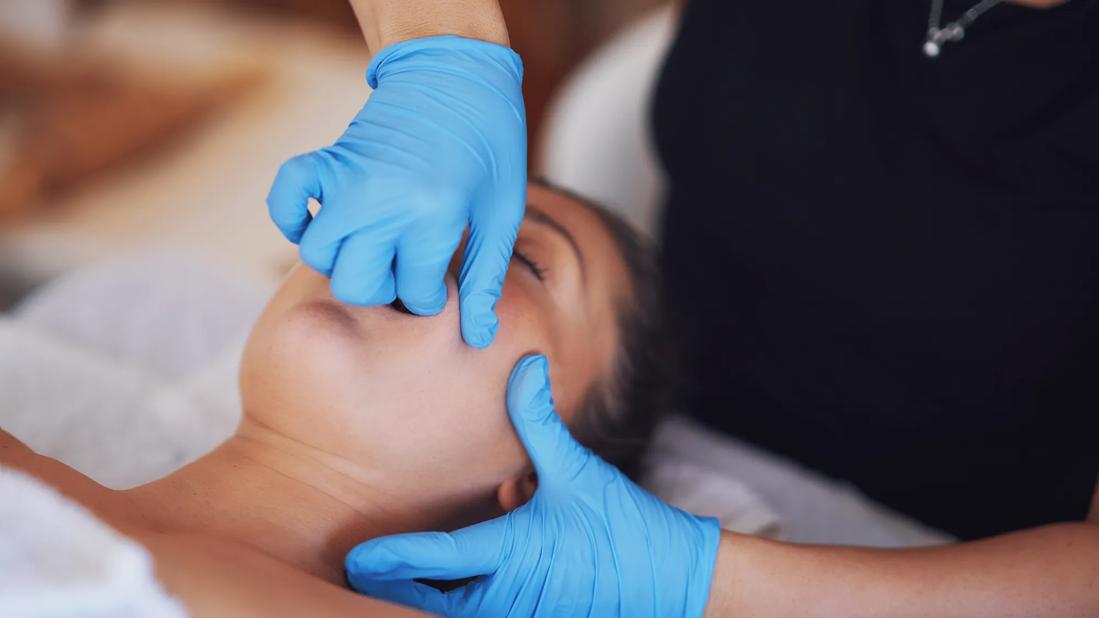TMJ Pain? Massage and Jaw Exercises May Help
Take a hands-on approach to release tension and reduce pain in your jaw muscles

Think about how often your mouth opens and closes during the day as you talk, chew, laugh, yawn … well, you get the point. That’s A LOT of movement — which explains why your jaw might sometimes ache.
So, how can you ease pain centered around the temporomandibular joints (TMJs) that connect your jawbone to your skull? Try a massage, suggests chiropractor Andrew Bang, DC.
What causes TMJ pain?
Muscles surround your hinge-like TMJs to power jaw movement. But like any other muscles in your body, the ones in your jaw can be overused and abused to the point where they cause soreness, says Dr. Bang.
Teeth grinding or clenching (bruxism), an injury (such as a broken jaw) or conditions like arthritis may also fuel muscle pain and even limit the use of your jaw.
Any of these factors behind temporomandibular dysfunction (TMD) can bring tightness and imbalance to your jaw muscles. Nearly 1 in 5 adults report that they annually experience a painful TMD episode lasting at least five days.
This can result in:
- Jaw pain or tenderness, often while chewing
- Headache or facial pain
- Clicking or cracking of your jaw
- Tinnitus (ringing in your ears)
- Difficulty opening or closing your mouth
How can massage ease TMJ disorders?
Blame for the TMJ-related pain often points a finger at the cheek-to-jaw masseter muscle and other facial muscles that help your jaw open and close. These muscles can become inflamed, tense and painful from overuse.
A massage can help mend those muscles, as direct pressure releases muscle knots (trigger points) that may be behind your discomfort. Kneading the tissue can help unravel ropey muscle fibers and bring relief.
“When the jaw muscles are overly tight or imbalanced, manual therapy works well to help restore normal muscle tone and balance between TMJ muscles,” explains Dr. Bang. “It can be highly effective.”
The concept is no different than dealing with a sore hamstring or shoulder. You’re just working out the kinks in a different muscle group.
How often should you get a TMJ massage?
The answer to this question depends on you and your specific symptoms and needs, says Dr. Bang.
Some people schedule weekly or monthly TMJ massage visits with a chiropractor, physical therapist or other massage professional to keep the joint working well. An average session may last about 30 minutes.
Talk to a healthcare provider to come up with a plan that works best for you.
Self-massage is also an option and can be done regularly. Dr. Bang suggests trying this kneading technique, which focuses on the masseter muscle. To do it:
- Locate your masseter muscle, which is below your cheekbone and about halfway between your mouth and ear.
- Relax your jaw.
- Using two or three fingers, apply pressure to the joint while moving your fingers in circular motions as you “knead” the muscles from top to bottom and back again.
Jaw exercises to ease TMJ pain
Simple jaw exercises can help stretch, strengthen and relax the muscles around your mouth. Here are four jaw exercises that Dr. Bang recommends trying at home or wherever you may be.
1. Jaw relaxation
Here’s something to think about: In moments of stress, you may be tensing your jaw without even realizing it. One of the most straightforward exercises to help your TMJs is to relax your jaw intentionally.
To do it:
- Touch your tongue to the roof of your mouth (behind your upper front teeth).
- While doing this, open and close your mouth slowly.
- Repeat several times.
In another variation of this exercise, place a finger in front of your ear on the lower part of your jaw at the TMJ joint. Place another finger on your chin and use it to open and close your mouth partially or fully.
2. Chin tucks
Chin tucks can help release jaw tension while also strengthening neck muscles and improving your posture.
To do it:
- Stand tall with your back against a wall.
- Pull your chin toward the wall, creating a “double chin” look.
- Hold for three to five seconds.
- Repeat several times.
3. Mouth resistance
Think of this exercise as a push-up for your mouth muscles. It’s an easy one to do, even if it does feel odd at first.
To do it:
- Place your thumb under your chin.
- While opening your mouth, apply pressure upwards to your chin with your thumb.
- Hold for three to five seconds before closing your mouth.
- Repeat several times.
In another variation of this exercise, squeeze your chin between your fingers to offer resistance as your mouth closes.
4. Side-to-side and front-to-back jaw movements
Consider this stretching and strengthening exercise the “hokey pokey” for your jaw. (Turning yourself around is optional.)
To do it:
- Put an object like a wooden craft stick between your top and bottom front teeth.
- Slowly move your jaw from side to side while clenching the item between your teeth.
- Thrust your bottom jaw forward so the bottom teeth are in front of the top teeth.
- Repeat several times.
If you’re looking to up the challenge, increase the thickness of the object between your teeth.
When to seek help for TMJ pain
Don’t let your jaw pain continue for weeks (or months!) on end. Massage is just one of many ways to find relief, says Dr. Bang. There’s also physical therapy, short-term muscle relaxers or a “night guard” to reduce teeth grinding at night.
“There are treatments available,” he emphasizes, “but it all starts with taking the first step to get help.”